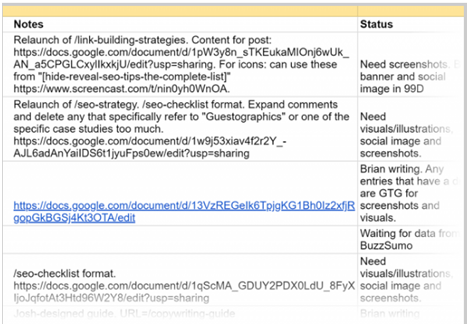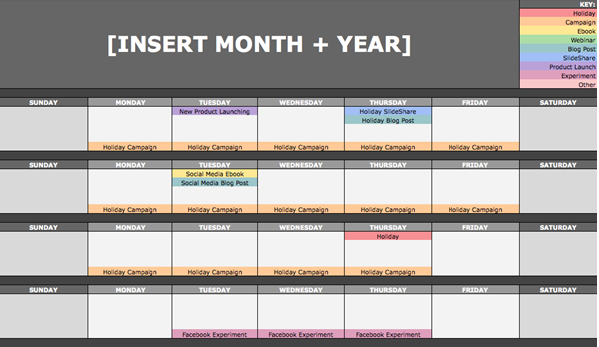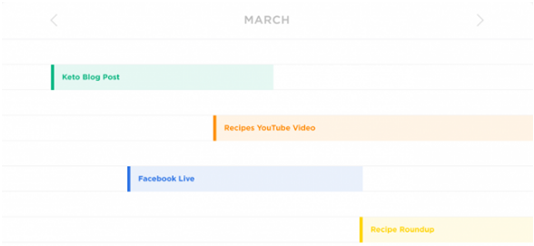Isn’t it surprising that 63 percent of businesses lack a documented strategy when it comes to creating online content? No wonder their efforts to capture the target markets fail to reach the full potential. This is where the most crucial element of content marketing – content calendar—comes into the picture.
Popularly known as an editorial calendar, a content calendar is an organizing tool to schedule and organize future content. The typical content calendar contains the list of upcoming content pieces, publication dates, titles, focus keywords, status updates, and other crucial elements. These elements vary based on the business and available resources.
With a content calendar, your business can keep all content marketing efforts organized. Tracking the activities and their results can become more efficient with this tool too.
However, before we dive deep into how to create a content calendar, let’s take a look at its 4 important aspects:
• Editorial – Your calendar must include pieces that you plan to publish and they should be scheduled in advance (even by a full year if needed). This way, you can keep checking your schedule and stick to it and know what you need to do next. But, do keep some room for flexibility as digital marketing trends keep changing quickly.
• Platform – This basically refers to the place where you have your content calendar. You can use a simple Google spreadsheet or an advanced tool or even go the traditional pen and paper route. However, when a lot of people are working on different content pieces, they will need to refer to one place where everything is visible to everyone. In which case, a spreadsheet helps. Tools like Trello and Basecamp can help you create a calendar too.

• Promotional activities – This covers how you intend to promote different content pieces and where. Like, do you need to send a newsletter about your latest e-book to your subscribers or promote a blog post on Facebook? Will you be doing a podcast on a very successful case study soon? If you are listing down promotional activities in the same calendar, just use a different color to make them easy to spot.
• Ideas for the future – Creative ideas can strike you anytime, while driving to office, taking a shower or while watching a movie! But, you need to jot them down somewhere, so that you can use them for building content in the future. So, include random topics or ideas in your calendar even if you are working on something else right now and schedule them later on.
Now, check out this step-by-step guide to create an excellent content calendar:
Step 1: Analyze your team to determine the type and amount of content you can create
Your content creation team must have multiple professionals, like graphic designers, editors, writers, and distribution specialists. Take a look at how much content they can churn out on a daily, weekly or monthly basis, without hurting the quality. Other than these content creators and distributors, you must have several subject-matter experts. Though they usually aren’t directly involved in the content creation process, but they can offer invaluable insights on a wide range of topics.
Step 2: Align your content marketing strategies with your business goals to populate the calendar
Your content calendar should be aligned with your business objectives, which means, it should cover topics and ideas that will get you what you want. For example, you can fulfill the purpose of ranking higher on Google’s search results with the right content pieces and schedule them in your calendar. So, you can create and publish high-quality, informative and engaging articles and blogs on your website with relevant keywords, so that search engines find them relevant and valuable. You can also plan to publish guest posts on various third-party portals to get quality backlinks.
Your goal can also be to target a particular set of customers to generate new leads. In that case, create useful content like e-books and whitepapers that go deep into a topic and solve the problems of your target group. You can then create a CTA (call to action) on your website for interested users to share their contact details to get access to these resources.
The goal of establishing your company as a thought leader can also be fulfilled through content marketing services. And by creating a content calendar, you can make your marketing efforts consistent and strategic. For instance, in this case, you can develop a set of comprehensive articles, videos, and podcasts that talk about an array of topics from your industry. Feel free to take the support of subject matter experts for creating valuable content for the end-users.
Step 3: Repurpose existing content for better reach than last time
Don’t ignore the content that you already have, as these can be repurposed to provide more value to the target audience. For instance, old blog posts can be updated with the latest information or made more comprehensive and converted into a whitepaper or e-book. Slide decks can be repurposed to create blog posts or videos for more engagement and better recall. Big reports or whitepapers can be used to create a blog series, with multiple posts on a broad topic.
Step 4: Determine the frequency of each content type
For a quarter, publish 18-20 blog posts on your portal. Select around six topics from these blog posts to prepare and publish guest articles on reputable third-party sites. Create two long-form contents – case studies, white paper, and/or an e-book. Organize a webinar and create multiple social media posts to promote it. The frequency of each content type can vary based on your team size and business goals.

Step 5: Choose a content calendar tool
Go for Google Sheets if you want a content calendar tool that offers easy collaboration and is free. For teams that have only one member, Google Calendar is an ideal option. Microsoft Excel spreadsheets are also a good idea for easy collaboration. The enterprise-level organization works best with Coschedule, though this tool can also be used by a single person, like a freelancer or consultant. With Loomly tool, you get interactive guides to create blog posts and automated social media posts.
Also Read: How do We Use Google Analytics for Marketing?
Step 6: Create the necessary columns in your content calendar
A content calendar must have these columns:
• Publication date
• Author(s)
• Title/topic/Working title
• Marketing goals
• Status (Published/approved/Edited)
• Questions to be answered by a subject-matter expert
• SEO keywords
• Call-to-action
• Publication goals
• Other Remarks
Make sure each collaborator understands the meaning and significance of each column.
Step 7: Finalize the topics with the help of your team
Set the duration for your brainstorming session, typically one-to-two hours. Allocate time for deciding the topic of each content type to avoid digression from the purpose of the meeting. Fill in your content calendar using the topics finalized and other necessary details.
Also Read: How do We Create Engaging Content?
Step 8: Schedule each part of the content creation workflow
To make your content calendar more robust, don’t just include the topics of different content pieces and their publishing dates. Schedule each stage of the content creation process as well. This is especially needed for complex or large projects. To understand this point better, take a look at the two calendars below – the first one is simple but the second is detailed and easier to track.

In other words, if you wish to create different content formats on a single topic, mention that in the calendar. If creating a blog post involves keyword research, making an outline, writing the post and adding visuals, then jot down each of these steps. This also helps when different people or teams are working on different steps. In the calendar, you can mention the team or employee who will handle each step too.
Also Read: Why Blogging Is Holy Grail of Content Marketing?
Step 9: Constantly monitor and update for best results
A content calendar is not something you can create once and forget about. You need to revisit it regularly, monitor how published content pieces are performing, perform audits and see if any old content needs to be taken down for better traffic or engagement. Also, since keeping the content fresh is important, you can schedule updates of easy-to-edit pieces such as blog posts. It is also wise to use analytics to measure your current content’s effectiveness in terms of numbers. For example, you might want to see if a content piece has been able to reduce the site’s bounce rate, or if it is generating more leads, or if it is making more people sign up for newsletter or visit your e-store. Then, you can tweak your strategy as well as content marketing calendar accordingly.
Step 10: Allow room for instant content requirements
Your content calendar must be flexible enough to meet the immediate content requirements. These requirements could be a collaboration with other industry leaders or latest industry development that requires your company to share the views via guest posts. The C-Suite is often invited to conferences and other business events, for which your team might be asked to prepare content. Ensure you have buffer time and resources for such requests.
Your takeaway
All the steps mentioned above clearly show why a content calendar is such an integral part of your content marketing efforts. With a calendar, you can make the process of content creation, distribution and promotion easy to track, analyze and tweak, to achieve the best ROI in the long run.





